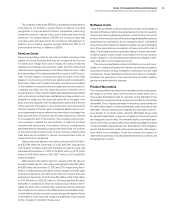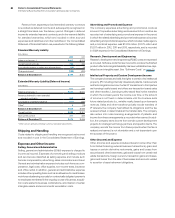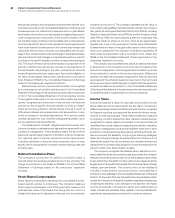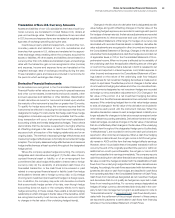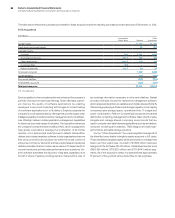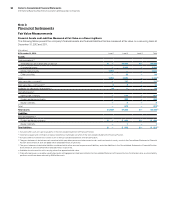IBM 2012 Annual Report Download - page 88
Download and view the complete annual report
Please find page 88 of the 2012 IBM annual report below. You can navigate through the pages in the report by either clicking on the pages listed below, or by using the keyword search tool below to find specific information within the annual report.Notes to Consolidated Financial Statements
International Business Machines Corporation and Subsidiary Companies
87
In December 2010, the FASB issued amended guidance to
clarify the acquisition date that should be used for reporting pro-
forma financial information for business combinations. If comparative
financial statements are presented, the pro-forma revenue and earn-
ings of the combined entity for the comparable prior reporting
period should be reported as though the acquisition date for all
business combinations that occurred during the current year had
been completed as of the beginning of the comparable prior annual
reporting period. The amendments in this guidance were effective
on a prospective basis for business combinations for which the
acquisition date was on or after January 1, 2011. There was no
impact in the consolidated financial results as the amendments
relate only to additional disclosures. In addition, the company has
had no acquisitions which required pro-forma financial information.
In December 2010, the FASB issued amendments to the guid-
ance on goodwill impairment testing. The amendments modified
step 1 of the goodwill impairment test for reporting units with zero
or negative carrying amounts. For those reporting units, an entity is
required to perform step 2 of the goodwill impairment test if it is more
likely than not that a goodwill impairment exists. In making that
determination, an entity should consider whether there are any
adverse qualitative factors indicating that impairment may exist. The
amendments were effective January 1, 2011 and did not have an
impact in the consolidated financial results.
In July 2010, the FASB issued amendments to the disclosure
requirements about the credit quality of financing receivables and
the allowance for credit losses. The purpose of the additional dis-
closures was to enable users of financial statements to better
understand the nature of credit risk inherent in an entity’s portfolio
of financing receivables and how that risk is analyzed. For end-of-
period balances, the new disclosures were required to be made in
all interim and annual periods ending on or after December 15, 2010.
For activity during a reporting period, the disclosures were required
to be included in all interim and annual periods after January 1, 2011.
In January 2011, the FASB temporarily deferred the disclosures
regarding troubled debt restructurings which were included in the
requirements of this amendment. Subsequently, in April 2011, the
FASB issued additional guidance and clarifications to help creditors
in determining whether a creditor has granted a concession, and
whether a debtor is experiencing financial difficulties for purposes
of determining whether a restructuring constitutes a troubled debt
restructuring. The new guidance and the previously deferred dis-
closures were effective July 1, 2011 applied retrospectively to
January 1, 2011. Prospective application was required for any new
impairments identified as a result of this guidance. These changes
did not have a material impact in the consolidated financial results.
In January 2010, the FASB issued additional disclosure require-
ments for fair value measurements. According to the guidance, the
fair value hierarchy disclosures should be disaggregated by class of
assets and liabilities. A class is often a subset of assets or liabilities
within a line item in the statement of financial position. In addition,
significant transfers between Levels 1 and 2 of the fair value hierar-
chy are required to be disclosed. These additional requirements
were effective January 1, 2010 for quarterly and annual reporting.
These amendments did not have an impact in the consolidated
financial results as this guidance relates only to additional disclo-
sures. Certain disclosure requirements relating to fair value
measurements using significant unobservable inputs (Level 3) were
deferred until January 1, 2011. These additional requirements also
did not have an impact in the consolidated financial results as they
related only to additional disclosures.
Note C.
Acquisitions/Divestitures
Acquisitions
Purchase price consideration for all acquisitions, as reflected in the
tables in this note, is paid primarily in cash. All acquisitions are
reported in the Consolidated Statement of Cash Flows net of
acquired cash and cash equivalents.
2012
In 2012, the company completed 11 acquisitions at an aggregate
cost of $3,964 million.
Kenexa Corporation (Kenexa)—
On December 3, 2012, the com-
pany completed the acquisition of 100 percent of Kenexa, a publicly
held company, for cash consideration of $1,351 million. Kenexa, a
leading provider of recruiting and talent management solutions,
brings a unique combination of cloud-based technology and consult-
ing services that integrates both people and processes, providing
solutions to engage a smarter, more effective workforce across their
most critical businesses functions. Goodwill of $1,014 million has
been assigned to the Software ($771 million) and Global Technology
Services (GTS) ($243 million) segments. As of the acquisition date, it
is expected that approximately 10 percent of the goodwill will be
deductible for tax purposes. The overall weighted-average useful life
of the identified intangible assets acquired is 6.5 years.
Other Acquisitions—The Software segment also completed eight
other acquisitions: in the first quarter, Green Hat Software Limited
(Green Hat), Emptoris Inc. (Emptoris) and Worklight, Inc. (Worklight),
all privately held companies, and DemandTec, Inc. (DemandTec),
a publicly held company; in the second quarter, Varicent Software
Inc. (Varicent), Vivisimo Inc. (Vivisimo) and Tealeaf Technology Inc.
(Tealeaf), all privately held companies; and in the third quarter,
Butterfly Software, Ltd. (Butterfly), a privately held company. Systems
and Technology (STG) completed two acquisitions: in the first quarter,
Platform Computing Corporation (Platform Computing), a privately
held company; and in the third quarter, Texas Memory Systems
(TMS), a privately held company. All acquisitions were for 100 percent
of the acquired companies.




